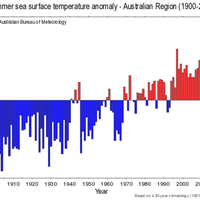'The blob': how marine heatwaves are causing unprecedented climate chaos
The Guardian, 18 Sep 2016.
Wide-scale disruption from warming oceans is increasing, but they could change our understanding of the climate, writes The Guardian.
First seabirds started falling out of the sky, washing up on beaches from California to Canada.
Then emaciated and dehydrated sea lion pups began showing up, stranded and on the brink of death.
A surge in dead whales was reported in the same region, and that was followed by the largest ever toxic algal bloom seen along the Californian coast. Mixed among all that, there were population booms of several marine species that normally aren’t seen surging in the same year.
Plague, famine, pestilence and death was sweeping the northern Pacific ocean between 2014 and 2015.
This chaos was caused by a single massive heatwave, unlike anything ever seen before. But it was not the sort of heatwave we are used to thinking about, where the air gets thick with warmth. This occurred in the ocean, where the effects are normally hidden from view.
Nicknamed “the blob”, it was arguably the biggest marine heatwave ever seen. It may have been the worst but wide-scale disruption from marine heatwaves is increasingly being seen all around the globe, with regions such as Australia seemingly being hit with more than their fair share.
It might seem strange given their huge impact but the concept of a marine heatwave is new to science. The term was only coined in 2011. Since then a growing body of work documenting their cause and impact has developed.
Continue reading the story at The Guardian.












